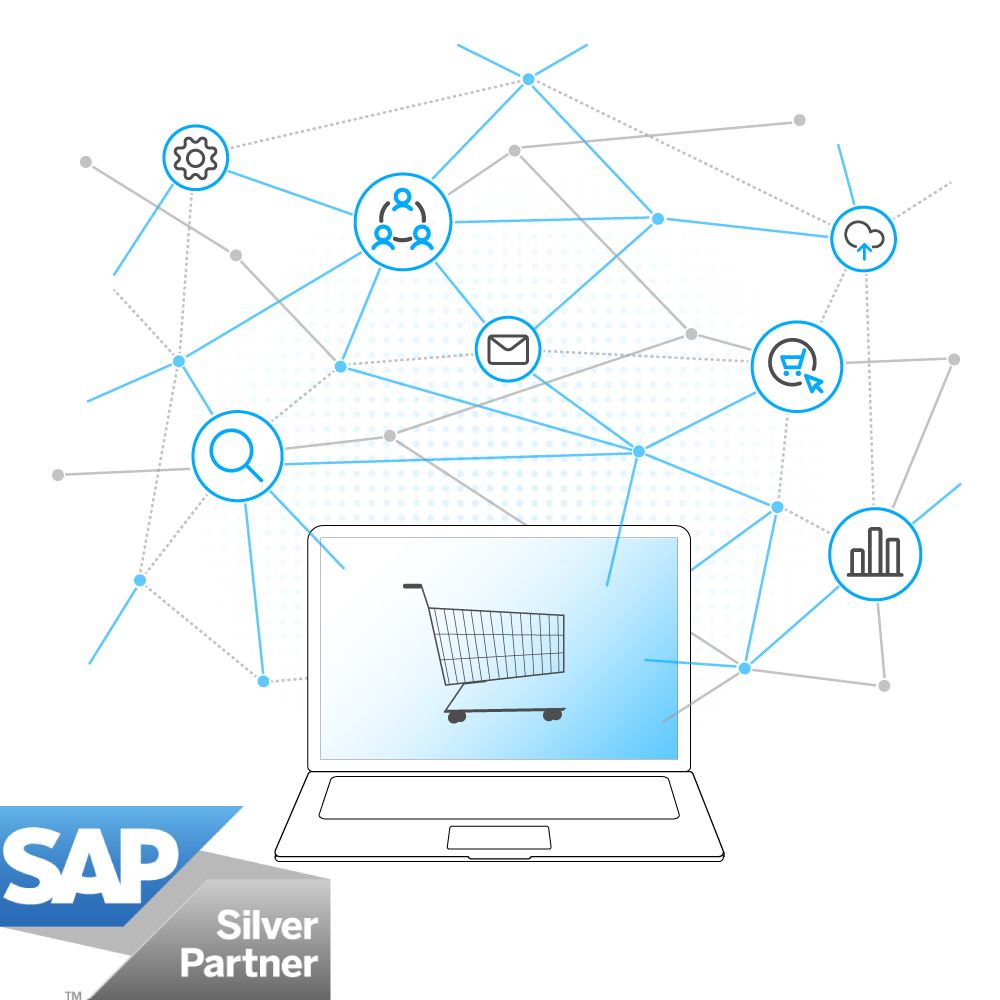Successful e-commerce with SAP Commerce Cloud
This is how online commerce benefits from cloud-based solutions. An expert interview

Fair weather clouds in the commerce sky: that is what the new cloud-based systems of various software providers promise. Together with our expert Jens Lauer, we took a closer look at one of them: The SAP Commerce Cloud.
Namics: SAP relies on cloud-based services, for example with SAP Commerce. What can we imagine in concrete terms?
Jens: In June 2018, SAP launched the SAP Commerce Cloud in the Public Cloud. The software provider had already provided other products such as marketing, sales, service and data on a cloud-based basis before – so it was only a matter of time before SAP added the commerce sector to the cloud portfolio.
Previously, customers and service providers had to deploy an on-premise solution themselves in their own data centre or with a hosting partner. The SAP Commerce Cloud now makes it possible to run the commerce solution via the SAP Cloud Portal in a standardised cloud environment.
From version 1808, SAP users can migrate their solution to the cloud. We recommend our customers to use the switch to the cloud to migrate to the latest version of SAP Commerce.
Namics: That sounds like a long time that customers have been left to their own devices. What concrete advantages does the change still offer e-commerce companies?
Jens: When it comes to the advantages of cloud solutions, the usual aspects are:
- modern, decoupled system architecture,
- no own setup and operation of hosting,
- standardised, more efficient deployments,
- a stable, scalable infrastructure with corresponding service level agreements (SLAs).
The cloud-based SAP products of the CX Suite are also perfectly coordinated and very high-performance.
The IT departments of our customers are constantly faced with the challenge of reducing expenditure while guaranteeing smooth operations. Cloud-based systems enable those responsible to achieve high availability and scalability at low prices via the SLAs offered. This means that the company does not need to purchase and operate its own hardware.
This is particularly important with regard to automated marketing measures: Cloud systems react directly to increased campaign traffic via server instances without the end customer noticing. This is also one of the great advantages of the SAP Commerce Cloud: a smooth customer experience. It prevents users whom we encourage to buy through efficient brand communication from dropping out due to poor platform performance.
Namics: An e-commerce company decides to move to the SAP Commerce Cloud - how should it proceed? Is the company preparing the switch to the cloud with SAP itself or is an existing agency taking over?
Jens: There are tasks that SAP has to do. The reason for this: In the SAP cloud environment, certain basic conditions have to be met. These can only be checked or executed by the software provider itself.
There are two possible approaches for the actual migration:
- In most cases, SAP partners such as Namics have implemented the commerce solutions for the user. SAP therefore recommends that these existing agencies migrate as well.
- Alternatively, SAP migrates – but this is more complicated because the software provider does not know the individual development and other systems in the digital ecosystem of the customer.
Five tips for migration to the SAP Commerce Cloud.
- Migration assessment: Carry out a migration assessment on the existing system together with SAP and the partner – for example Namics. This allows all parties involved to assess how complex the migration and its preparations are. In the case of individually developed systems, the framework conditions of the SAP cloud must be aligned with the existing solution – for example, the extensions used must be compatible with the SAP Commerce Cloud.
- Upgrade core: Use the move to the cloud to bring your online platform up to the latest version. You should implement this upgrade on a regular basis anyway – if you plan accordingly, you can implement it directly with the deployment in the cloud.
- Setup system, code adaptations, data & media migration: To ensure that your custom code also runs error-free in the cloud, we adapt it if necessary and have your databases transferred to the SAP cloud environment. Code refactoring may also be useful for you – by improving the structure of your source code, you will increase the quality and performance of your software.
- 3rd-party integration: Check external systems with which the SAP Commerce Cloud communicates for cloud compatibility.
- Testing, stage and product deployment: We test all functionalities in the new system environment. Once the customer has successfully accepted the system, the SAP Commerce Cloud can go live.
Namics: Is a switch to the cloud also combined with risks for a company?
Jens: In an ideal world, we want to implement standardised solutions in our projects with our customers. If we integrate an SAP commerce solution, we connect existing systems to it and take over features for the individual business processes of the customers. These may not be 1:1 compatible when migrating to the cloud. We identify and eliminate such risks in the migration assessment mentioned above.
Namics: When talking about cloud, the question of where the data is located very often arises. What are the options for companies that rely on the SAP Commerce Cloud?
Jens: SAP currently uses the Microsoft Azure Cloud. Other cloud providers may be added in the future. When implementing the individual cloud products, the customer can decide in which data centre the cloud solution is set up. These data centres are spread across various regions. Depending on legal requirements, the user can focus on specific areas. In Europe, for example, there are data centres in Frankfurt and Amsterdam for the SAP Commerce Cloud.
Namics: SAP Upscale also has to do with commerce - how does this solution differ from the new SAP Commerce Cloud?
Jens: With SAP Upscale Commerce, the software provider offers a SaaS solution for B2C shops in addition to the SAP Commerce Cloud. In contrast, the SAP Commerce Cloud supports the B2B, B2B2C and B2C marketing models as standard.
SAP Upscale can be set up with a very manageable amount of effort and offers an intelligent engine that analyses the behaviour of the end customer and combines it with the company's goals (e.g. sales), thus enabling the customer to be presented with optimal suggestions in the shop. SAP sees three main examples as use cases here:
- the rapid introduction of new products
- testing of markets,
- test of pop-up stores.
In our perspective, this cloud-based solution complements a commerce strategy fairly well.
Namics: First the SAP Commerce Cloud – and then? Let's take a look into the future: where is the journey in e-commerce heading?
Jens: E-commerce companies need a unified customer experience across every touchpoint to engage potential and existing customers with their brand.
Technologically, companies face the challenge of recognising their customers across all channels and delivering the message that is relevant at the time. Especially in B2B commerce – where the SAP Commerce Cloud is particularly strong – the personal approach is becoming increasingly important. The customer must receive the right message at the right time. For this we need a 360° view of the user.
Therefore SAP has launched a new product, the Customer Data Platform. On the platform, customer data is aggregated in real time from various systems to form a profile.Machine learning enables us to recognise behaviour patterns and anticipate appropriate interactions.
However, a solid IT strategy will always be an important factor, especially in order to avoid isolated solutions. API-first Microservices, for example, enable you to populate any touchpoint with the same content and processes.
Do you want to move to the cloud with your current SAP Commerce solution? As an SAP Silver Partner we can look back on more than 15 years of cooperation and 60 successful projects. Our experienced experts look forward to accompanying your company on its way to the cloud.












